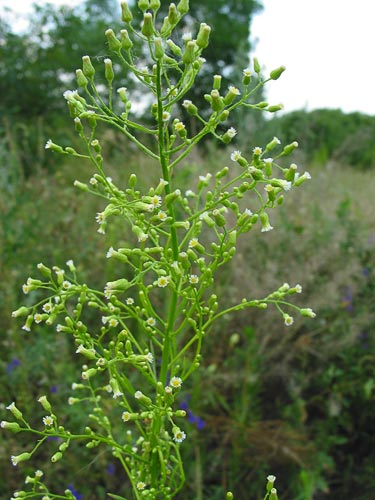Weeds
Conyza canadensis (L.) Crong. - Canada Fleabane, Horseweed, Marestail.
Taxonomic position.
Family Asteraceae, genus Conyza L.Synonym.
Erigeron canadensis L.Biological group.
Annual spring weed, able to develop as winter weed.Morphology and biology.
Plant reaches 3 to 200 cm in height. Root fusiform. Stalk straight, costate, covered with rigid simple hairs bent upward. Leaves green, erect, linear-lanceolate 0.1 to 11 cm in length and 0.2 to 18 mm in width. Lower leaves petiolate, serrate-dentate, not richly covered along both sides with large rigid hairs bent upwards. Plant leaves gradually become smaller apicad, losing denticles, whereas pubescence remains on leaf margins only. Lower leaves sessile. Inflorescence paniculate. Anthodia numerous, 3-5 mm in diameter, located, more or less, on long stems. Inner leaflets of involucre linear, pointed, bare, grassy, membranous at margins; outer ones two times shorter, grassy, with upwards bent simple hairs posteriorly. Marginal flowers feminine, ligular, white, 2.5-3.5 mm in length, arranged in a few rows, covered with single short hairs in upper part of tube. Inner flowers pale yellow, bisexual, tubular, cylindrical, four-dentate, covered with short hairs in upper part. Pappus white, up to 3 mm in length, flattened. Hemicarp light gray, oblong, 1.25 mm in length, 0.25 mm in width, and 0.2 mm in thickness, weakly flattened, slightly narrowed basad, with sparse short hairs directed upward. Blossoming occurs in July-November. One plant produces more than 100,000 hemicarps. Weight of 1,000 seeds is 0.043 g. It is spread by pappose seeds, which are easily carried by wind for a great distance.Distribution.
The European part of the former USSR, the Caucasus, Western and Eastern Siberia, the Far East, Central Asia, Scandinavia, Middle and Atlantic Europe, the Mediterranean, Asia Minor, Iran, Mongolia, Japan, China, North America.Ecology.
Prefers light ground, dry places. Seeds of the weed germinate from depths no more than 1-1.5 cm. The minimum temperature for seed germination is +6-8°C; optimum is +18-28°C.Economic significance.
Weed of grain (winter rye in particular); tilled, vegetable crops; cotton. Control measures include autumn plowing, pre-sowing cultivation, thickening of summer cereals, weeding in autumn of winter cereals, harrowing in spring, maintenance of crop rotation, use of herbicides if necessary.Reference citations.
Chesalin, G.A. 1975. Weeds and their control. Moscow: Kolos. 256 pp. (in Russian).Keller, B.A., Lyubimenko, V.N., Maltsev, A.I., Fedtshenko, B.A., Shishkin, B.K., Rodzevich, R.Yu., Kamenskii, K.V., eds. 1935. Weed plants of the USSR. Moscow & Leningrad: AN USSR. V.4. 414 pp. (in Russian).
Komarov, V.L., ed. 1959. Flora of the USSR. Moscow & Leningrad: AN SSSR. V. 25: 231. (in Russian).
Makarova, V.A. 1955. Control of weeds. Rostov-na-Donu: Rostov Publishing House: 9. (in Russian).
Veselovs.kii, I.V., Lisenko, A.K., Man.ko, Yu.P. 1988. Atlas-synopsis of weeds. Kyiv: Urozhai. 64 pp. (in Ukrainian).


